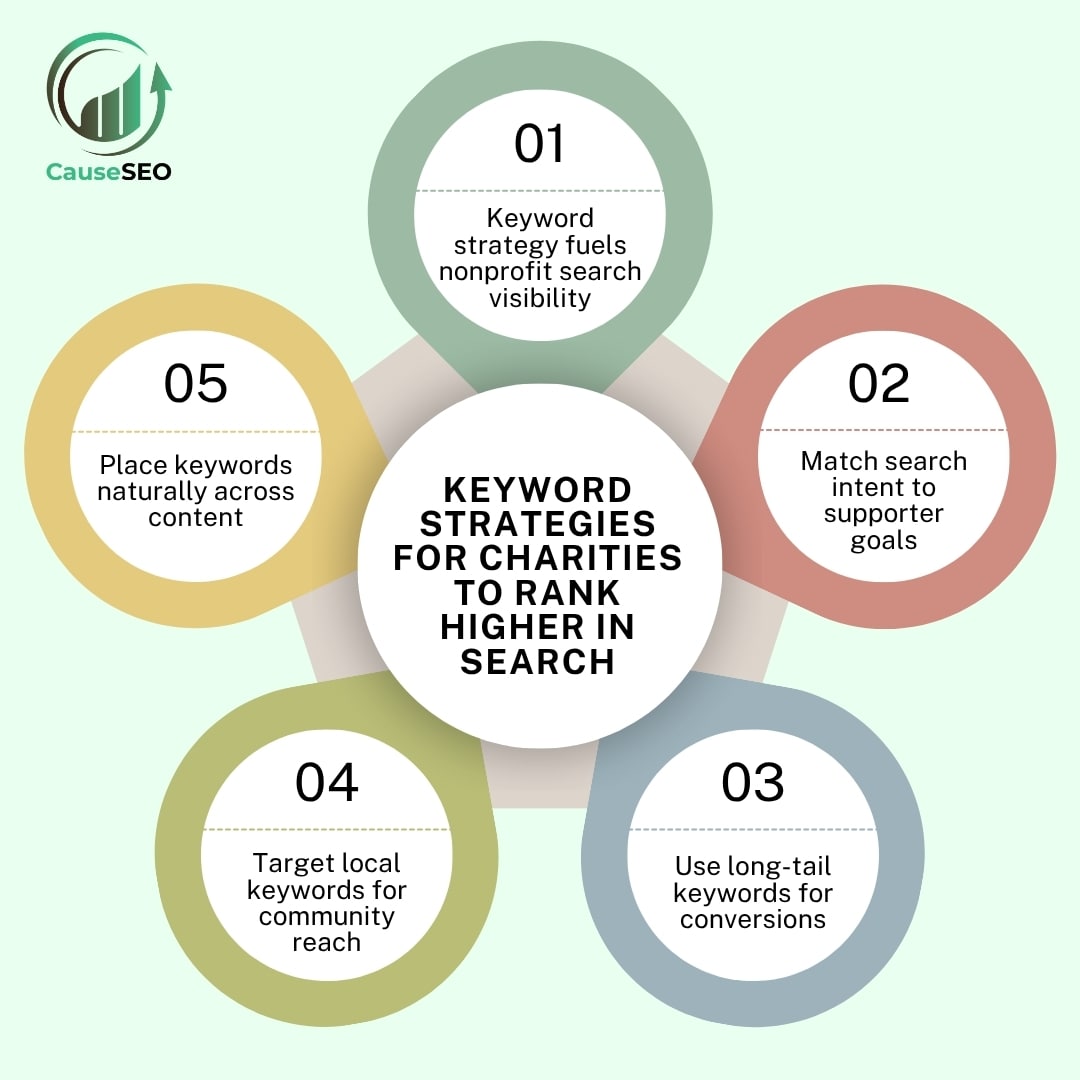When it comes to increasing online visibility, keywords are the foundation of search engine optimization (SEO). For charities and nonprofits, using the right keywords can mean the difference between being discovered by a potential donor or being overlooked entirely. That is why understanding keyword strategies for charities is so important—these strategies help organizations appear in search results when it matters most.
Yet many charities do not use keywords strategically. They might focus on their mission but miss out on how people actually search for help, support, or opportunities to contribute. This article walks through practical, easy-to-follow strategies that nonprofits can use to improve their search rankings.
Whether you’re just starting or looking for SEO services for charities, this post offers step-by-step insight based on what works in real campaigns.

Understanding Keyword Intent for Nonprofits
What Is Keyword Intent?
Keyword intent refers to the reason behind a search. It typically falls into four categories:
- Informational: The user is looking to learn something (e.g., “how to start a food drive”).
- Navigational: The user wants to find a specific site (e.g., “UNICEF website”).
- Transactional: The user intends to take action (e.g., “donate to disaster relief”).
- Local: The user is searching for nearby solutions (e.g., “animal shelter near me”).
For charities, intent matters more than just traffic numbers. A keyword like “climate change facts” may bring visitors, but “donate to reforestation project” signals readiness to give. Understanding this difference helps you focus on terms that support real outcomes like donations or volunteer signups.
Matching Intent with Nonprofit Goals
Different goals require different keyword types:
- For donations: Use transactional intent keywords like “donate to refugee relief” or “sponsor a child in Haiti.”
- For awareness: Informational terms such as “facts about global hunger” are useful for blog content.
- For volunteers: Combine intent and location: “volunteer tutoring in Winnipeg” is specific and actionable.
Aligning your content with user intent ensures you reach people who are looking for what you offer.
How to Do Keyword Research for Charities
Tools and Techniques
You don’t need to spend a lot of money to find the right keywords. Start with:
- Google Keyword Planner: Great for seeing search volume and suggestions.
- Ubersuggest: Helpful for discovering related phrases and difficulty levels.
- Ahrefs or SEMrush: Offers deeper insights but may be best for teams with a budget.
- AnswerThePublic: Reveals questions people ask about your cause.
Look for keywords with moderate volume and low competition. Also check the “People Also Ask” section on Google—it’s a free insight into what real people want to know.
Build Keyword Lists Around Campaigns and Content Themes
Instead of guessing, group your keywords into categories like:
- Donation-focused: “donate to women’s shelters,” “charity fundraising ideas”
- Local-based: “volunteer opportunities in Winnipeg,” “food pantry near [city]”
- Educational: “homelessness statistics Canada,” “what causes food insecurity”
These keyword clusters help you stay organized and create relevant pages that support your campaigns.

Types of Keywords Charities Should Target
Branded vs. Non-Branded Keywords
- Branded: Include your organization’s name (e.g., “CauseSEO charity SEO services”).
- Non-branded: General terms like “SEO for nonprofits” or “how to help during natural disasters.”
Both matter. Branded keywords help supporters find you directly. Non-branded ones capture people who do not yet know your name but are looking for services you provide.
Long-Tail Keywords for Specificity and Lower Competition
Long-tail keywords are longer, more detailed phrases such as “how to sponsor a child in Uganda.” These are easier to rank for and often convert better because they show clear intent.
Instead of “refugee aid,” aim for “how to help refugees in Canada 2025.” It narrows your audience but improves engagement.
Local and Geo-Targeted Keywords
If your work is community-based, use location in your keywords:
- “pet adoption center in Toronto”
- “mental health charity near me”
These terms help you connect with supporters in your area—especially those ready to act.
Where and How to Use Keywords Effectively
Page Titles, Meta Descriptions, and Headings
Include keywords naturally in your titles and headings:
- Good: “Volunteer Opportunities in Winnipeg”
- Avoid: “Winnipeg Volunteer Charity Help Organization NGO Support”
Meta descriptions should be clear, compelling, and under 160 characters. This helps with click-through rates and SEO ranking.
Body Content and Internal Links
Spread keywords throughout your body text, but do not overdo it. If it sounds forced, revise it.
Use internal links with anchor text that includes keywords. For example, link “donate to our campaign” to a donation page rather than just “click here.”
Image Alt Text and URLs
Alt text improves accessibility and can support your SEO. Use phrases like:
- Alt text: “SEO training for charities graphic showing keyword impact”
- URL: “/seo-services-for-charities”
These small changes add up.
Measuring Keyword Performance
Using Google Search Console
Google Search Console helps track which keywords drive traffic to your site. You can view:
- Total clicks and impressions
- Click-through rate (CTR)
- Average keyword position
Use this data to find underperforming pages or keywords worth focusing on.
Refining Keyword Strategy Over Time
SEO is not set-and-forget. Remove keywords that no longer drive results. Add new ones based on donor behavior or search trends.
For example, if “how to support Gaza” trends in your space, create content around it while it’s relevant.

Common Keyword Mistakes Nonprofits Make
Targeting Generic Terms
Avoid vague terms like “help” or “nonprofit organization.” These are too broad to rank well and do not match strong user intent.
Ignoring Search Intent or Overusing Jargon
Do not use internal language your donors don’t understand. Instead of “capacity-building initiative,” use “training program for community leaders.”
Clarity matters more than cleverness.
Frequently Asked Questions
Q1: How do I know what keywords people use to find causes like mine?
Use tools like Google Search Console and AnswerThePublic to discover search behavior around your topic.
Q2: How many keywords should I target per page?
Focus on one primary keyword and two to three secondary keywords per page.
Q3: What is the best free keyword research tool for small nonprofits?
Google Keyword Planner and Ubersuggest are great starting points.
Q4: Can I rank without blogging if I use good keywords?
It’s possible, but harder. Regular content gives search engines more to index.
Q5: How often should I update or review my keyword strategy?
Every 3–6 months is ideal, or anytime you launch a new campaign.
Q6: Should I focus more on ranking or on clicks/conversions?
Conversions matter more. A lower-traffic keyword that brings donors is better than a high-traffic term that doesn’t.
Conclusion
A solid keyword strategy helps your nonprofit stand out online, not just for visibility but for real engagement. The right keywords connect your message with the people searching for it—whether they want to learn, give, or help.
CauseSEO specialize in the best SEO for charities and nonprofits. We helped Trees for the Future increase donation page traffic by 315%. Let us help you too.
Looking for SEO services? Request a free SEO audit for your nonprofit today.
[Request a Free Nonprofit SEO Audit]

